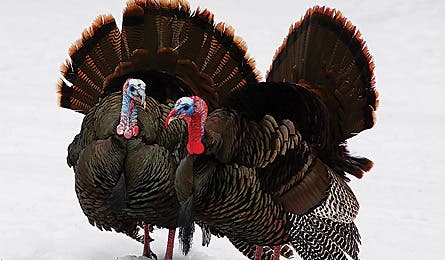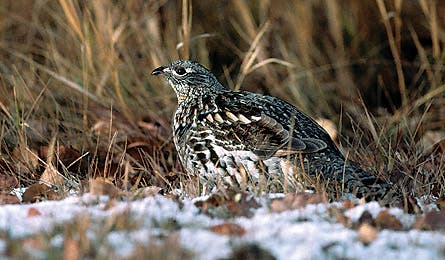See More: Winter Birds

'Wild Turkey (Jeremie Hollman)'

Wild Turkey (Jeremie Hollman)

Ruffed Grouse (Michael H. Francis)
WHITE-TAILED PTARMIGAN
The pigeon-size ptarmigan thrives on wind-whipped tundra in Alaska, the Rockies, the Cascades, and the Sierra Nevada. At home among scree and glaciers, the birds have been known to cool off in the snow when temps get too high. In the summer, mottled gray-brown feathers help the birds hide in plain sight; dwindling autumn daylight triggers a seasonal molt that turns them snow-white.
Cold-weather adaptations
Feathers around the ptarmigan’s nostrils warm the air before it reaches the lungs; specialized muscles fluff its plumage to create air pockets; and an extra layer of down adds enough insulation for subzero survival. Ptarmigan conserve energy by walking instead of flying–strutting across the snow on stiff-feathered feet that act like snowshoes.
WILD TURKEY
Native to eastern and southern mixed forests, these birds once had a dim reputation: Some Cheyenne and Apache tribes wouldn’t eat them for fear of acquiring their apparent stupidity. But the Thanksgiving staple still suffered from over-hunting in the early twentieth century. It has since proven itself a survivor: Today, wild turkeys thrive across the country.
Cold-weather adaptations
Turkeys prep for winter by gorging on grains, hawthorn, and snowberry fruits, boosting fat reserves to 25 percent of their body weight and providing extra insulation and energy to sustain them for days if they’re stranded by storms or treed by predators. More than 5,000 feathers also keep each bird warm. Turkeys seek safety in numbers by banding together in packs that can exceed 200 members; by night, they roost high in the trees, away from snow–and foxes or coyotes.
RUFFED GROUSE
During the spring mating season in the Rockies, Northeast, and southern coastal states, this chickenlike bird (aka partridge) is often heard before it’s seen: Males “drum” the air by flapping arched wings, producing an accelerating thumping sound. A spooked grouse might also take a hiker by surprise, exploding from the brush with a frenzied flapping. Chiefly a ground bird, it can take short flights and even hover over the forest floor.
Cold-weather adaptations
Grouse grow lateral scales on their widespread toes each fall that, when extended, provide traction for gripping icy branches and buoyancy for walking on snow. They seek warmth by huddling together, roosting low in evergreens, or diving into snowbanks. Even if freezing rain traps them in these makeshift caves, grouse can survive for several days, eating snow for water.